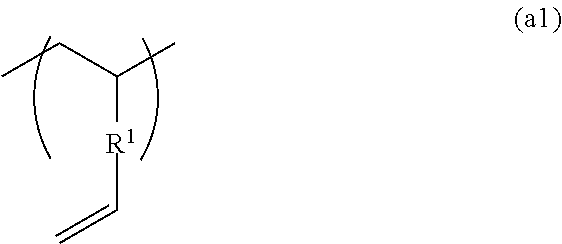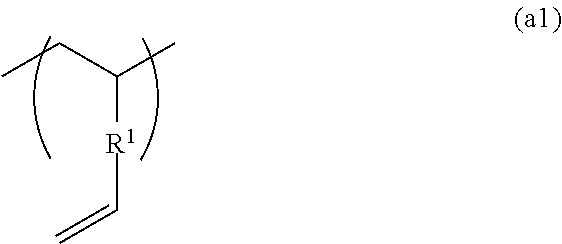Ultraviolet ray-curable resin composition used in inkjet printing and optical element obtained using same
a technology of ultraviolet light and resin composition, applied in the field of resin composition, can solve the problems of no attempt to apply copolymer to inkjet process in any literature, and difficult to eliminate, and achieve the effect of excellent transparency and hardness
- Summary
- Abstract
- Description
- Claims
- Application Information
AI Technical Summary
Benefits of technology
Problems solved by technology
Method used
Image
Examples
example 1
Preparation of Ultraviolet Curable Resin Composition (P1)
[0063]15 parts of the phenylethyl methacrylate-terminated polydivinylbenzene (PDV) described above, 5 parts of trimethylolpropane triacrylate, 9 parts of 2-hydroxyethyl acrylate, 50 parts of 1,4-butanediol diacrylate, 20 parts of 1,9-nonanediol diacrylate, 7 parts of Irgacure 184 (manufactured by Ciba Specialty Chemicals Inc.), 0.05 part of ADK STAB AO-60 (manufactured by ADEKA CORPORATION), and 1.1 parts of a diethylene glycol diacetate solution containing 10% of a surfactant BYK 378 (manufactured by BYK-Chemie Japan K.K.) were mixed to form a homogeneous solution. The solution was filtered through a 0.2-μm microfilter to prepare an ultraviolet curable resin ink (P1). The ink had a viscosity of 19.9 mPa·sec, a surface tension of 25.1 mN / m, and a density of 1,055 kg / m3.
[0064]A 5-inch alkali-free glass AN-100 (manufactured by ASAHI GLASS CO., LTD.) was used and subjected to a deep UV treatment for 1 minute in advance (substrate...
examples 2 and 3
[0069]Resin composition inks P2 and P3 were prepared by changling compositions as shown in Table 1. The physical property values were similarly shown in Table 1.
[0070]It should be noted that compounds in Table 1 and Table 2 are as described below.
[0071]SR-213; 1,4-butanediol diacrylate manufactured by Sartomer Japan. Inc.
[0072]LIGHT ACRYLATE 1,9ND-A; 1,9-nonanediol diacrylate manufactured by Kyoeisha Chemical Co., Ltd.
[0073]LIGHT ESTER HOA; 2-hydroxyethyl acrylate manufactured by Kyoeisha Chemical Co., Ltd.
[0074]BYK378; silicon-based surfactant manufactured by BYK-Chemie Japan K.K.
[0075]SR-351S; trimethylolpropane triacrylate (TMPTA) manufactured by Sartomer Japan Inc.
[0076]Irgacure 819; Irgacure 819 (bis(2,4,6-trimethylbenzoyl)-phenylphosphine oxide) manufactured by Ciba Specialty Chemicals Inc.
[0077]Irgacure 184; Irgacure 184 (1-hydroxy-cyclohexyl-phenyl-ketone) manufactured by Ciba Specialty Chemicals Inc.
[0078]Irgacure 907; Irgacure 907 (2-methyl-1-[4-(methylthio)phenyl]-2-morph...
example 4
[0091]A 5-inch alkali-free glass substrate (AN-100 manufactured by ASAHI GLASS CO., LTD.) was washed with acetone and dried. Then, a substrate I-2 having as contact angle of 12° with respect to the resin ink P1 was prepared.
[0092]Subsequently, through use of an inkjet head (KM512SH, specification: 4 pl) manufactured by Konica Minolta Holdings, Inc., a 10-minute continuous ejection test on the ultraviolet curable resin ink (P1) was performed at a driving frequency of 4.8 kHz and an applied voltage of 18.54 V. The ink did not cause any nozzle clogging and exhibited a satisfactory ejection characteristic.
[0093]Through use of one nozzle of KM512SH, dot drawing was performed at a stage speed of 125 mm / sec and a dot pitch of 75 μm / drop, and immediately after that, exposure was performed with a UV in-line exposure machine (manufactured by HOYA-SCOTT, run at 125 mm / sac, cumulative amount of exposure: 64 mJ / cm2) on an inkjet stage. In addition, exposure was performed at 2,000 mJ with a one-s...
PUM
| Property | Measurement | Unit |
|---|---|---|
| boiling point | aaaaa | aaaaa |
| surface tension | aaaaa | aaaaa |
| refractive index | aaaaa | aaaaa |
Abstract
Description
Claims
Application Information
 Login to View More
Login to View More - R&D
- Intellectual Property
- Life Sciences
- Materials
- Tech Scout
- Unparalleled Data Quality
- Higher Quality Content
- 60% Fewer Hallucinations
Browse by: Latest US Patents, China's latest patents, Technical Efficacy Thesaurus, Application Domain, Technology Topic, Popular Technical Reports.
© 2025 PatSnap. All rights reserved.Legal|Privacy policy|Modern Slavery Act Transparency Statement|Sitemap|About US| Contact US: help@patsnap.com


